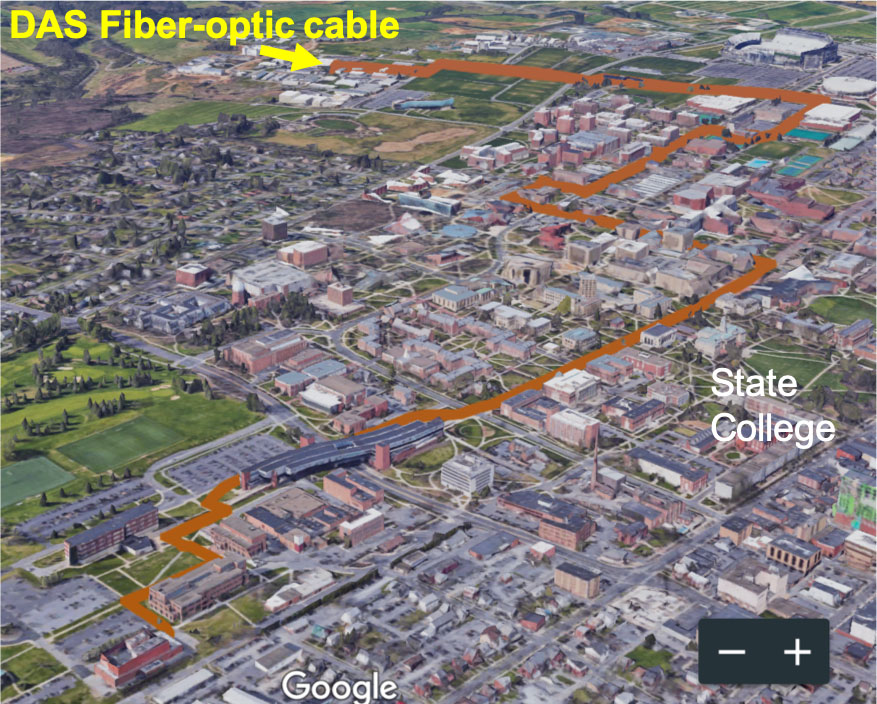
Bird's-eye view of the fiber-optic cables used for the FORESEE project in which scientists used pre-existing cables to monitor geological events.
Fiber-optic cables run underneath nearly all city grids across the United States and provide internet and cable TV to millions, but what if those systems could also provide valuable information related to hazardous events such as earthquakes and flooding? A team of researchers at Penn State have found they can do just that.
The scientists are using fiber-optic distributed acoustic sensing (DAS) technology to turn existing telecommunication infrastructure that is already installed underground into a valuable resource for monitoring ground vibrations.
“We discovered the fibers could pick up a wide variety of signal vibrations, from thunderstorms to human walking steps to music concerts,” said Tieyuan Zhu, assistant professor of geophysics at Penn State and principal investigator on the project. “We can even distinguish the specific song at a concert by the patterns of the high and low tones. That's a great demonstration of the sensitivity of these sensors.”
Traditional seismic monitoring devices, called geophones, are difficult to deploy in urban areas. Obtaining permission and space to install sensors, protecting sensors against theft and vandalism, and the high costs to maintain them makes it prohibitive to gain reliable long-term data, the scientists said.
DAS technology allows scientists to plug into unused fiber, called dark fiber, greatly reducing the cost and setup time that hinders traditional seismic monitoring devices. A laser interrogator unit simply needs to be plugged into one end of a stretch of fiber to begin collecting data, the scientists said.
“Several experiments in California have been carried out by teams using existing telecommunication infrastructure,” Zhu said. “But deploying this technology on the East Coast is important because we have very special geology here.”
The soil and shallow bedrock in the Allegheny Mountains region create complex near-surface geophysical properties. The underlying bedrock can slowly dissolve due to circulating groundwater, which can form sinkholes and caverns. Especially in urban areas, sinkhole collapse and settling issues can threaten human safety and property. In addition, strong seasonal variations in temperature and precipitation create a very different environment to that of California.
Zhu and his research team created the Penn State Fiber-Optic foR Environmental SEnsEing (FORESEE) project, the first deployment of the DAS technology in the eastern U.S. The goal of this project was to address the long-standing challenge of real-time monitoring of environmental and subsurface physical, chemical, and biological changes in urban areas. FORESEE also aims to develop the DAS fiber sensing arrays to turn the Penn State University Park campus and surrounding areas into a living lab for the collection of highresolution data on environmental, energy, and infrastructure systems. The researchers report their results in Solid Earth.

Recording example from a local mining blast in May.
The team gained access to dark fiber-optic cables beneath the campus and converted the cable to 2,300 seismic sensors using DAS. They then continuously recorded ground vibration data along the three-mile stretch starting in April 2019. The experiment generated many tens of terabytes of data, which was stored in a network-attached storage server. The server was then connected to an internet network, providing the scientists with remote data access in real time. The density of the DAS recordings provided extraordinary resolution that enabled insight into their cause and allowed the researchers to distinguish between various signals, the scientists said.
The preliminary results suggest DAS has the capability to sense broadband vibrations and discriminate between the seismic signatures of different earthquakes and anthropogenic sources from events such as mining blasts, vehicles, music concerts, and walking steps.
But DAS does not come without limitations. Traditional geophones have three components, two horizontal sensors and one vertical sensor, allowing them to capture vibrations in all directions. DAS technology, however, is only able to sense vibrations horizontally as there is no need for vertical sensors in fiber-optic cables meant for internet and cable. Therefore, the data is not as comprehensive as data from traditional geophones.
“We know this is a limitation,” Zhu said. “Hopefully in the next five years, this can be overcome by new fiber-optic technology.”
In addition to its geological uses, DAS can yield insights into varying patterns of human activities relevant to public health and urban planning. Traffic monitoring and redirection that does not require private cell phone data, gunshot detection, industrial noise pollution monitoring, and subsurface water utility monitoring may all be improved through the use of DAS technology, the scientists said. The value of DAS has also been recognized in inaccessible and harsh environments, enabling offshore ocean observations and the ability to monitor permafrost stability in the Arctic.
Now that the researchers know what the technology can do, Zhu said their next step is using DAS to monitor smaller events longterm, like the underground movements that lead to sinkholes and flooding. They also want to look at the events that occur where the atmosphere meets the earth since there is currently no way to monitor how a thunderstorm’s energy impacts the solid earth’s near surface.
“DAS arrays utilizing existing telecommunication fibers can play an increasing role in the development of resilient, sustainable cities,” Zhu said.
Other contributing researchers included Junzhu Shen, doctoral student, and Sam Hone, graduate student, both in geosciences at Penn State; and Eileen R. Martin, assistant professor of computational mathematics at Virginia Tech.
The U.S. Department of Energy partially supported this work.

